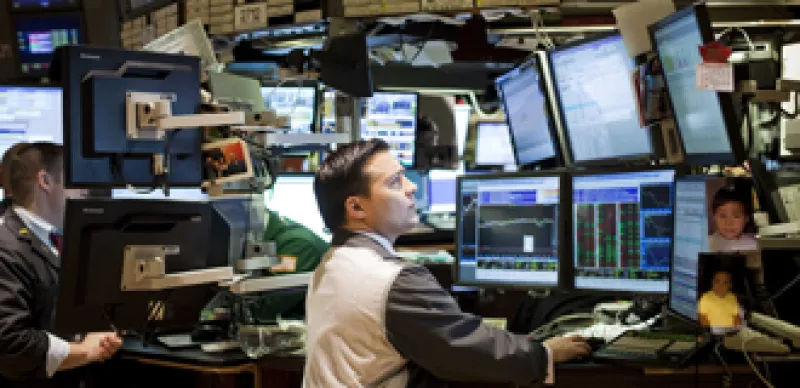Increased automation and a new generation of hybrid trading systems are making it far easier for institutional investors to trade commodities ranging from energy and agricultural futures to emissions contracts. Systems developed and refined over the past half-decade enable portfolio managers to set criteria that route trades to be executed either automatically or by voice contact with a broker, whichever is likely to get the best result.
An easier-to-use trading environment could lead to “significant growth” for global commodities over the next several years, says Vincent van Lith, vice president of BHF-Bank, a German private bank that is one of the largest players in the European energy markets.
Two developments account for the wave of innovative hybrid trading systems, notes van Lith. First, the migration of almost all commodities contracts from traditional pit trading to the OTC market, essentially moving them into an electronic environment. The other factor was the 2008 global markets collapse, when many equity strategies crashed but commodities investors prospered.
That sparked new interest in commodities from pension funds and endowments, hedge funds and trading companies. For instance, IntercontinentalExchange, a firm that operates regulated global futures exchanges, clearing houses and OTC markets, recently reported average daily volume across all of its futures exchanges of 1.37 million contracts in November 2010 – up more than 25 percent from November 2009.
The problem was the very different configuration of the commodities markets. Most contracts are traded largely in one place, rather than across a variety of exchanges, dark pools, and other platforms, as with equities. Some commodities boast deep, highly liquid markets with thin price margins, lending themselves to sophisticated algorithmic strategies aimed at capturing those margins. Others are thinly traded and less predictable, requiring the judgment of a human trader.
Beach Horizon, a London-based futures manager that trades global commodity, financial, and foreign exchange instruments, has dealt with the configuration problem by developing its own screens that enable it to split its trades into three groups. One set of trades is “fully automated,” says Paul Netherwood, a partner at Beach Horizon, meaning orders are routed directly for electronic execution. A second group is “trader-led,” going first to a trader who makes a call on liquidity, after which they may be routed either for direct electronic execution using an algorithmic program, or electronic execution via the screens. A third set of trades, mostly in thinly traded contracts, go straight to a broker for voice execution.
What makes the system work is the vastly improved access to market data that's evolved since commodities shifted to OTC. Beach Horizon's systems access “market depth,” which shows the prices and sizes of the full order book and other data. “Seeing all that gives you an idea where the action is,” Netherwood says, enabling its systems to direct trades where they will receive the best execution.
The enhanced system gives Beach Horizon the confidence to trade in a broad range of commodities markets. Other managers restrict themselves to contracts with deep markets and high trading volumes that demand less human intervention on trades. But investors don't have to create their own software to enjoy some aspects of a hybrid system. ICAP Energy, a UK-based interdealer broker, last year launched TrueQuote, a brokerage service for OTC crude, fuel oil and Middle Distillate swaps that allows users to execute trades either electronically or through an actual broker. Other providers creating front-end systems that embrace commodities trading include RTS Realtime Systems AG and Trading Technologies.
Responding to higher demand, software providers are also making it easier for banks and brokers to give their clients direct access to commodities markets. Traditionally, getting access to enough markets to buy and sell commodities broadly was difficult. “In Europe alone, you had to be a member of umpteen exchanges,” notes Anthony Bordin, sales and business development manager at Trayport, a UK firm that specializes in software development for energy markets. “That could include the exchange for the Amsterdam power region, another for France, another for Russia, etc. Membership could be quite costly and obtaining it could be a long, involved process.”
Trayport operates GlobalVision Portal, an automated trading platform that allows firms and traders to access markets in power, coal, gas, emissions, and freight products. GlobalVision Portal links them directly into exchanges that house the software in their data centers. That means firms can access all the markets that house GlobalVision Portal – a group that includes almost all European exchanges and a growing number of exchanges around the world – without having to become general clearing members of those exchanges.
The other major obstacle for investors wanting to access the commodities markets was pre-trade risk checking. Most clearing houses impose cash and limit requirements to ensure that the buyer has sufficient capital to sustain big losses. Bilateral counterparty trades in OTC energy markets normally include only large players, to ensure that the trades pass stress tests for credit adequacy. But that means many potential market participants are rejected needlessly as being too small or undercapitalized. This year, Trayport launched EMA Gateway, an automated system for general clearing members to ensure that only pre-checked orders go to the OTC broker or exchange.
BHF-Bank is the first user of the new EMA system, which van Lith believes will streamline the pre-trade process for investors that are just starting out trading energy contracts.”Improvements such as this will help commodities trading worldwide to grow enormously in the near future,” he predicts, by making the process less complex and more user-friendly.






